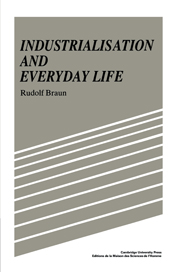Book contents
- Frontmatter
- Contents
- Prefaces
- Acknowledgements
- Note on measures and coinage
- Introduction
- 1 The preconditions for industrialisation
- 2 Changes to the structure of family and population in the industrial regions
- 3 Life and society of the population engaged in industry
- 4 The impact of industrialisation on the house and the rural economy
- 5 Work in the putting-out industry and its effect on the life of the common people
- 6 The outworkers' attitude to poverty and crises
- 7 Conclusion
- Postscript
- Appendix: a note on the administrative structure and social stratification in the countryside of Zurich during the Ancien Régime
- Notes
- Sources and bibliography
- Index
1 - The preconditions for industrialisation
Published online by Cambridge University Press: 16 March 2010
- Frontmatter
- Contents
- Prefaces
- Acknowledgements
- Note on measures and coinage
- Introduction
- 1 The preconditions for industrialisation
- 2 Changes to the structure of family and population in the industrial regions
- 3 Life and society of the population engaged in industry
- 4 The impact of industrialisation on the house and the rural economy
- 5 Work in the putting-out industry and its effect on the life of the common people
- 6 The outworkers' attitude to poverty and crises
- 7 Conclusion
- Postscript
- Appendix: a note on the administrative structure and social stratification in the countryside of Zurich during the Ancien Régime
- Notes
- Sources and bibliography
- Index
Summary
Those parts of the Zurich territory to be caught up soonest in the putting-out industry lay near to the city, in the regions around the Lake (the Zurichsee) and in the province of Knonau. In the seventeenth century the Zurich textile manufacture also drew the Oberland within the catchment area for cottage industry. Raw materials from foreign lands were brought to the forest valleys to be processed and with them came a system of production based on new social and economic foundations. The industrialisation of the Oberland had begun.
Before this process began, however, yarn was already being produced locally, as part of the peasants' agricultural output. Growing flax and especially hemp was an important item in the annual budget both for wealthy peasants and for poor day-labourers, and was as such highly regarded. Even the poorest families tried to get hold of a Hanfländli (little field of hemp) alongside their Krautgärtli (vegetable patch). Often enough such a Hanffäckerli (little acre of hemp) would be all the land they owned. In numerous parishes the hemp pounds were part of the commonage enjoyed by those parishioners entitled to use it.
In rainy or winter weather, no farmhouse was without its busily spinning wives and daughters, with their husbands and children, or an attentive lover, preparing the fibres for them. They also tried to produce more yarn than they needed, using the profit to offset their heavy debts. Yarn carders went from farmhouse to cottage, buying up their wares. In places with a weekly market (Wald 1621) the market regulations insisted on all spun fibres and yarn being sold there.
- Type
- Chapter
- Information
- Industrialisation and Everyday Life , pp. 8 - 36Publisher: Cambridge University PressPrint publication year: 1990

